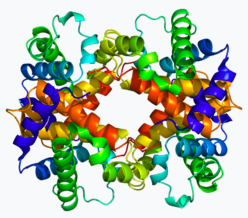A point mutation in the beta-globin gene changing the codon from glutamate to Lysine will likely cause what disease?
2 Answers
This would entirely depend on where the residue is located in the folded protein.

Glu is negatively charged and Lys is positively charged at physiological pH. If we assume that Glu is part of a salt bridge somewhere in the protein (either near the hydrophobic interior or near the exterior) we can generally conclude that electronic repulsion and subsequent disruption of the salt bridge would result if the residue was mutated to Lys. If it isn't part of a salt bridge and is only a surface residue that interacts with water, less severe folding consequences would result. Ultimately, however, the protein would fold in a different way that would disrupt its function.
HBB's normal function is to carry oxygen in erythrocytes to various cell populations in the body needed for cellular respiration. Hence, we can deduce that this may result in pathology concerning oxygen saturation and/or delivery to various tissues.
This has been associated with either polymerization (and perhaps consequent lysing of the the erythrocytes) or crystallization into microspherocytes.
1: Hirsch, R. E., Lin, M. J., Vidugirus, G. V., Huang, S., Friedman, J. M., & Nagel, R. L. (1996). Conformational Changes in Oxyhemoglobin C (Glu Lys) Detected by Spectroscopic Probing. Journal of Biological Chemistry, 271(1), 372-375. doi:10.1074/jbc.271.1.372
Glutamic acid is normal amino acid in 6th position of beta globin polypeptide of haemoglobin. It is replaced by lysine in mutated form. Such mutant allele is found in African population.
The mutation forms haemoglobin C compared to normal haemoglobin A.
HbC mutation in homozygous condition causes mild anaemia, as haemoglobin C tend to crystallise and RBCs may not survive full term (which is close to 120 days).
Heterozygous genetic combination of Hb C along with Hb S may cause more serious symptoms of haemolytic anaemia.

